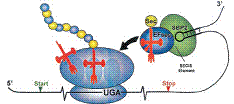Biochemistry, Department of

Vadim Gladyshev Publications
Document Type
Article
Date of this Version
March 2006
Abstract
Sec (selenocysteine) is a rare amino acid in proteins. It is co-translationally inserted into proteins at UGA codons with the help of SECIS (Sec insertion sequence) elements. A full set of selenoproteins within a genome, known as the selenoproteome, is highly variable in different organisms. However, most of the known eukaryotic selenoproteins are represented in the mammalian selenoproteome. In addition, many of these selenoproteins have cysteine orthologues. Here, we describe a new selenoprotein, designated Fep15, which is distantly related to members of the 15 kDa selenoprotein (Sep15) family. Fep15 is absent in mammals, can be detected only in fi sh and is present in these organisms only in the selenoprotein form. In contrast with other members of the Sep15 family, which contain a putative active site composed of Sec and cysteine, Fep15 has only Sec. When transiently expressed in mammalian cells, Fep15 incorporated Sec in an SECIS- and SBP2 (SECIS-binding protein 2)-dependent manner and was targeted to the endoplasmic reticulum by its N-terminal signal peptide. Phylogenetic analyses of Sep15 family members suggest that Fep15 evolved by gene duplication.


Comments
Published in Biochemical Journal 394:3 (March 15, 2006), pp. 575–579. Copyright © 2005 The Biochemical Society, London. Used by permission.